Understanding Non-Alcoholic Beer: A Comprehensive Guide
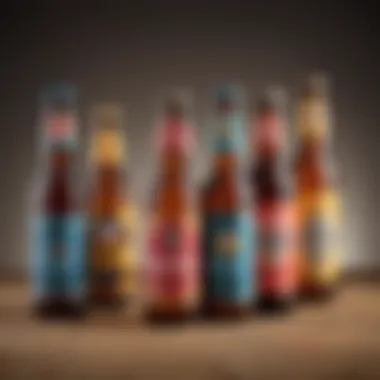
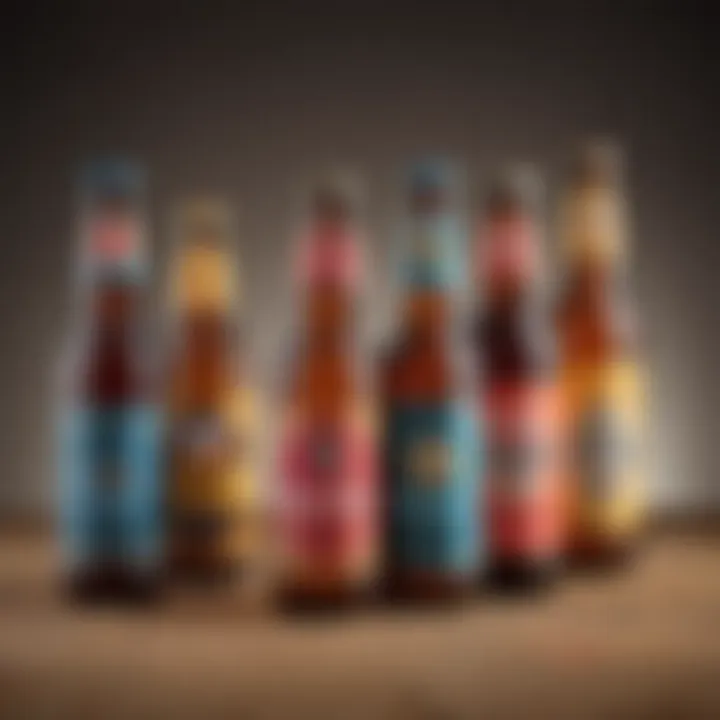
Intro
In recent years, non-alcoholic beer has surged in popularity, carving out a significant niche in the broader beverage landscape. Once deemed the drinking choice of people avoiding booze due to personal or health-related reasons, the market has transformed dramatically. Society's changing attitudes towards health and wellness, coupled with an increasing demand for diverse flavor profiles, has allowed this category to blossom.
As we delve into this emerging trend, it’s essential to explore the foundations of non-alcoholic beer. How it's made, its flavor variations, and what health implications it may carry, play a significant role in understanding its rise. Furthermore, with a plethora of brands stepping into the ring, each offering unique brews, there’s much to discuss regarding what sets these drinks apart.
Through this exploration, we aim to create a robust guide that doesn’t just skim the surface but dives deep into the various elements that make non-alcoholic beer a worthy contender in the beverage market. Whether you’re a connoisseur who relishes every sip or a casual drinker looking to make informed choices, the narrative that follows seeks to illuminate this expansive world.
Prelude to Non-Alcoholic Beer
In recent years, non-alcoholic beer has transcended its previous niche, emerging as a viable option for a broad range of consumers. More people are recognizing it not just as a substitute for alcoholic alternatives but as a distinct category standing on its own merits. The importance of diving into this topic cannot be overstated, especially in a world where health consciousness is climbing the ladder of priorities. With rising interest from various demographics, this article aims to shed light on the multifaceted nuances of non-alcoholic beer.
Historical Context
The roots of non-alcoholic beer can be traced back to times when sobriety was emphasized during certain cultural or religious practices. The prohibition era in the United States stands as a pivotal moment in the non-alcoholic beer history, where many breweries began crafting products with less than 0.5% alcohol content to cater to public demand. This legacy began to change over the decades, particularly in the late 20th century when some innovative breweries began honing in on brewing techniques that not only catered to those abstaining from alcohol but also appealed to a broader audience.
Noteworthy is how non-alcoholic beer has evolved within various societies. In places like Germany, the emphasis on non-alcoholic variants has long been a part of the beer culture, whereas in other regions, awareness and acceptance have recently burgeoned. As sentiments tied to drinking habits shifted, the landscape began to transform, making room for creativity in flavor profiles and brewing processes.
Market Growth Trends
The market for non-alcoholic beer is witnessing a surge akin to a roller coaster on a perfect summer day. Reports suggest that it is not merely a passing fad but rather an enduring trend indicative of changing consumer preferences. The shift towards healthier lifestyles has led to growing acceptance among diverse age groups, particularly millennials and Gen Z.
Some key trends contributing to this growth include:
- Increased Variety: The introduction of various styles—from crisp lagers to hoppy ales—means there's something for everyone. Brands keen on differentiating themselves are not just mimicking alcoholic beers but are creating unique blends that stand on their own.
- Health Consciousness: Consumers are placing a premium on mindful drinking. Non-alcoholic beer offers a way to enjoy beer without the consequences of intoxication, which appeals to health-minded individuals.
- Social Acceptance: There’s been a noticeable cultural shift where choosing non-alcoholic options isn’t seen as abstaining but rather as a smart lifestyle choice. More social environments today embrace non-alcoholic beer on their menus, facilitating its accessibility.
"The non-alcoholic beer market is projected to continue its upward trajectory, fueled by innovations and changing consumer sentiments."
Understanding Non-Alcoholic Beer
In today's culture, non-alcoholic beer has become more than just a trend; it symbolizes a shift in lifestyle and consumer choice. People are increasingly curious about how to enjoy beer without the buzz, and that curiosity has given rise to a growing market overflowing with options. Understanding non-alcoholic beer not only opens doors to diverse flavors and styles but also promotes a healthier way of enjoying social gatherings. Learning about this segment presents an opportunity to appreciate the craftsmanship behind brewing while still being mindful of one’s health.
Definition and Composition
Non-alcoholic beer is often defined as a beverage that has a minimal alcohol content, typically less than 0.5% by volume, which distinguishes it from traditional beers. The composition usually mirrors that of regular beer, typically containing water, malt, hops, and yeast. What’s fascinating is the way brewers replicate the beer experience without the intoxicating effects. The secret lies in the fermentation process where the alcohol is either partially or fully removed while retaining as much flavor as possible. It’s a delicate balance, combining science and art to deliver a refreshing drink that satisfies without the side effects of alcohol.
Types of Non-Alcoholic Beers
The world of non-alcoholic beer isn’t just confined to a single style; it embraces several types, each offering unique characteristics that cater to different palates.
Lager Variants
Lager variants, widely recognized for their crispness and refreshing taste, are among the most popular non-alcoholic options. The clean finish and mild flavor make them an easy choice for casual drinkers. One key characteristic is their smoothness; they appeal to those who enjoy light beers.
The unique feature of lagers is the fermentation method, which involves cooler temperatures leading to a slower fermentation process. This method retains the drink’s hearty body while delivering a satisfying flavor. However, a potential disadvantage can be the lack of stronger, more complex flavors found in ales. Still, for those seeking a versatile option that pairs well with a variety of foods, lagers stand out as a solid choice.
Ale Varieties
Ale varieties bring a different character to the non-alcoholic beer scene. Known for their robust flavors and aromatic profiles, these beers often contain a higher level of hops. This makes them a popular pick for those who crave more depth and complexity in their drink. The fruity and sometimes spicy notes in ales can make every sip a delightful experience.
A notable aspect of ales is their warmer fermentation temperature, which allows for the development of those rich flavors. However, the boldness of some ale varieties can be a double-edged sword; while they provide a complex tasting experience, they might not appeal to those who prefer simpler flavor profiles. In the context of this article, ales exemplify the diversity of taste that non-alcoholic options can offer.
Specialty Beers
Specialty beers encompass a wide range of unique brews that don’t fit neatly into the lager or ale categories. These often include seasonal flavors, experimental brews, or those infused with special ingredients like fruits or spices. The creativity seen in specialty beers showcases the innovation within the non-alcoholic segment.
What makes specialty beers especially appealing is their adventurous nature; every bottle can present a new experience. Some of these beers may even provide health benefits due to added ingredients like herbs or superfoods. However, it’s essential to note that the unconventional flavors might not suit everyone’s tastes, which makes them a bit riskier for anyone new to non-alcoholic options. Still, their uniqueness can be enticing and shows how non-alcoholic beer continues to evolve.
"Non-alcoholic beer serves as a bridge that connects us to the age-old tradition of brewing, while adapting to modern preferences for health and wellness."
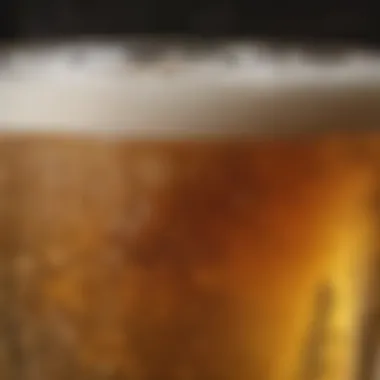
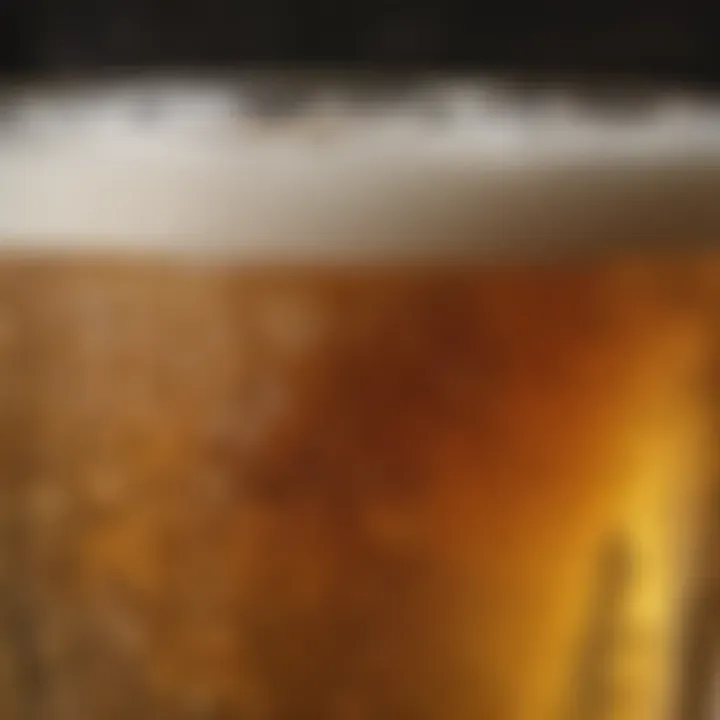
As we delve deeper into the various aspects of non-alcoholic beer, it becomes clear that understanding these definitions and types enriches the overall appreciation of what this beverage segment has to offer.
Production Process of Non-Alcoholic Beer
The production process of non-alcoholic beer is a pivotal aspect of understanding how this beverage reaches its audience. As the demand for healthier alternatives to traditional alcohol-based drinks increases, knowing how non-alcoholic beer is crafted provides insights into its appeal.
The methods employed not only influence the taste but also determine the nutritional profile of the final product. They highlight the innovations in brewing techniques that cater to the ever-evolving consumer preferences who seek rich flavor without the drawbacks of alcohol.
Brewing Techniques
The brewing techniques for non-alcoholic beer closely mirror those of traditional brewing but come with careful adjustments. Most non-alcoholic beers start with the same base ingredients: malted grains, hops, yeast, and water. Understanding these methods gives a glimpse into the artistry behind the brew.
One critical point is that the brewers need to create a balance between developing rich flavors while ultimately limiting the alcohol content. Some breweries utilize specialized yeasts that naturally produce less alcohol during fermentation. Others might focus on manipulating the fermentation time and temperature for a distinct taste profile while keeping the alcohol at bay. The beauty of these techniques lies in their adaptability, allowing brewers to innovate and fine-tune the results based on market desires.
Alcohol Removal Methods
After brewing, the next challenge is effectively removing alcohol while preserving the beer's essence. Various methods exist, each with its own benefits and quirks, that are used in this removal process.
Boiling
Boiling is one of the oldest methods used for alcohol removal. The principle is quite straightforward: by heating the beer, the alcohol evaporates at a lower boiling point compared to water. This technique allows the brew to maintain its flavor components while shedding the undesired alcohol content. Another strong point for boiling is its ability to concentrate flavors, as certain volatiles are retained. However, a downside is that excessive boiling may lead to the loss of some delicate aromas, which could affect the overall flavor profile. It introduces a richness that many might find appealing but requires a careful balance to achieve the best outcome without dulling the beer's subtleties.
Filtration
Filtration presents a more modern option for alcohol removal. In this technique, various filtration processes harness advanced technology to separate alcohol from the beer. The key characteristic of filtration is its ability to preserve more of the original flavors and aromas when compared to boiling. Essentially, it runs the beer through a specialized filter that operates under conditions that allow alcohol to pass while retaining the beloved flavors. Yet, the drawback here involves the possibility of altering the mouthfeel or body of the beer if not done correctly. It’s a highly precise method that demands attention to detail to ensure desired outcomes.
Vacuum Distillation
Vacuum distillation is often considered a high-tech method for alcohol removal. By creating a vacuum, the boiling point of alcohol is lowered, enabling its evaporation at much lower temperatures. This method is beneficial in that it causes significantly less loss of volatile flavor-behavior compared to boiling. The unique feature of vacuum distillation lies in its efficiency and its ability to produce a beer that retains many of the characteristics found in traditional brews. Nevertheless, it requires substantial investment in technology, making it less accessible for smaller breweries. In particular, the equipment needed can be costly, potentially restricting smaller players from adopting this approach.
In summary, the production of non-alcoholic beer is a complex dance of tradition and innovation, employing various techniques that allow brewers to capture essence while adapting to a careful balance of flavors and alcohol content. Choosing the right method is instrumental in how these brews are perceived by consumers.
Top Non-Alcoholic Beer Brands
The increasing interest in non-alcoholic beer has made it essential to focus on the brands leading this significant shift in consumer preferences. With a variety of options available, understanding what sets these brands apart is vital for anyone exploring this category. Highlighting top brands introduces readers to distinctive flavors, brewing techniques, and innovative approaches that cater to different tastes. This section aims to demystify the choices within the non-alcoholic beer landscape, breaking down the segments into mainstream, craft, and international selections, thus providing a comprehensive guide.
Mainstream Options
When talking about mainstream non-alcoholic beers, it’s hard to miss the giants in the industry who have taken active steps to capture this growing market. Brands like Heineken, Clausthaler, and Budweiser have entered the fray with their own non-alcoholic variants, allowing consumers to enjoy the familiar taste without the alcohol.
These beers often emphasize the brand's established flavors and characteristics. For example, Heineken 0.0 offers a balanced profile, retaining some of the crispness and bitterness of the traditional lager. This is important as many casual drinkers still desire that recognizable taste that they've come to enjoy in alcoholic counterparts. The benefit of opting for mainstream options is that they're widely available, making them an accessible choice for consumers curious about non-alcoholic offerings.
Craft Non-Alcoholic Beers
Craft breweries have carved out their niche in the non-alcoholic beer market, leading to a surge in creative and flavorful options. Breweries such as Athletic Brewing Company and BrewDog have pioneered a movement towards truly innovative production techniques, exploring unique ingredients and brewing methods that separate their products from mainstream options.
- Athletic Brewing offers a selection that includes stouts and IPAs, which are typically less common in the non-alcoholic space.
- BrewDog has gone beyond traditional styles, exploring ever more delightful combinations like fruit-infused beers.
This branching out into craft non-alcoholic beers encourages culinary experimentation. With such diverse flavors available, food lovers of all ages can pair these brews with their favorite meals, enhancing the dining experience. Craft beers often come with more personality and storytelling, making them an exciting choice for those looking to explore beyond the ordinary.
International Selections
Global trends shape the non-alcoholic beer landscape significantly, with international brands making waves alongside domestic choices. These brews provide a glimpse into diverse brewing cultures, showcasing how various regions approach the creation of non-alcoholic options. Brands such as Paulaner and Erdinger from Germany offer traditional German brewing styles, while local favorites like Brewdog's international variants expand the flavor palate further.
Unpacking international selections can be a thrilling experience for the palate.
- Paulaner Weissbier Non-Alcoholic delivers the classic wheat beer experience, conjuring up notes of banana and clove.
- Erdinger Alkoholfrei continues the tradition of premium lager with a refreshing twist.
The increase in treasure troves of international options enriches the consumer's experience by proving that a non-alcoholic lifestyle does not mean compromising on taste.
Exploring different brands of non-alcoholic beers can lead to surprising discoveries that might become new favorites for culinary adventures.


Overall, delving into the top non-alcoholic beer brands allows drinkers to transition smoothly into this evolving market while enjoying familiar flavors or venturing into uncharted territories.
Taste and Flavor Profiles
Understanding the taste and flavor profiles of non-alcoholic beer is crucial for both consumers and brewers alike. In a time when more individuals are choosing to reduce their alcohol intake, the demand for flavorful alternatives has skyrocketed. Non-alcoholic beers must not only mimic the taste of traditional brews but also provide a unique flavor experience that satisfies various palates. This involves a careful balance of ingredients, innovation in brewing techniques, and a deep understanding of how flavors interact.
For consumers, tasting and exploring non-alcoholic beers can be both an adventure and an education. The landscape is as diverse as the flavors found in alcoholic counterparts, and discerning individuals find joy in identifying subtle notes, whether it be hints of caramel, citrus, or roasted grains. Non-alcoholic beers often serve as a conversation starter in social settings, encouraging tastings and pairings in a way that is inclusive for everyone, regardless of their alcohol preferences.
Comparative Analysis
In a comparative analysis of non-alcoholic beers, it’s notable how flavor profiles can vary significantly across different brands and styles. The taste might differ based on brewing methods, ingredients, and the specific techniques used for removing alcohol. For example, some breweries employ boiling methods, which can concentrate flavors but may also produce a less refined taste. Others opt for vacuum distillation, preserving delicate flavors often lost through traditional heat methods.
One key finding in this analysis is the impact of raw materials on the final product. Hops, for instance, provide bitterness and aroma. Various hop varieties contribute entirely different flavor notes. A beer brewed with Cascade hops might present floral and citrusy characteristics, while a brew utilizing Saaz hops may offer a more earthy, herbal profile.
Here’s a snapshot of some popular flavor profiles found in non-alcoholic beers:
- Crisp and Clean: Common in many lagers, often characterized by a refreshing mouthfeel.
- Fruity and Zesty: Found more in ales, with prominent citrus tones standing out.
- Malty Sweetness: A hallmark of darker brews, where flavors of caramel, toffee, and even chocolate can appear.
"Each non-alcoholic beer tells its own story through its taste, and often it's all about experimentation and preference."
Flavor Innovations
The world of non-alcoholic beer is not stagnant; it is constantly evolving with flavor innovations that cater to adventurous palates. Breweries have recognized that to capture the interest of taste-driven consumers, creativity is paramount. This has led to an explosion of flavors that far exceed the traditional norms.
Here are a few innovations reshaping the flavor landscape:
- Fruit Infusions: Adding various fruits during brewing can create exciting flavor combinations. Breweries might use everything from berries to tropical fruits, enhancing aroma and taste complexity.
- Spice Addition: Some brewers take cues from craft cocktails, experimenting with spices like ginger, coriander, or even chili to add warmth and depth.
- Barrel Aging Techniques: While traditionally associated with alcoholic beers, barrel aging is now being used in non-alcoholic brews to impart rich, woody flavors, sometimes infusing hints of bourbon or rum.
- Non-Standard Ingredients: Ingredients like coffee, tea, or herbal components are also being incorporated to push flavor boundaries.
As brewers experiment with these innovations, consumers gain access to an ever-wider array of options that may surprise them, turning what many perceived as a limited category into a vibrant tapestry of taste. Through these efforts, non-alcoholic beer is carving a respected place on the table, firmly challenging the notion that you must sacrifice flavor for alcohol-free choices.
Health and Nutritional Aspects
Exploring the realm of non-alcoholic beer necessitates a keen understanding of its health and nutritional implications. As consumers become more conscientious about their choices, the demand for non-alcoholic options has soared. Non-alcoholic beer often provides a suite of benefits that appeal to health-conscious individuals as well as those seeking social inclusion without the effects of alcohol.
Nutritional Benefits
Non-alcoholic beer isn't just a substitute; it often boasts nutritional attributes that the average alcoholic counterpart may lack. Take, for instance, the presence of vitamins and minerals. Many varieties contain nutrients like B vitamins, which are essential for energy production and metabolism. Moreover, certain beers are fortified with electrolytes, catering particularly to those post-exercise.
Additionally, some studies suggest that moderate consumption of non-alcoholic beer might support heart health and improve circulation, thanks to the presence of polyphenols—antioxidant compounds seen predominantly in plant-based foods. Thus, it can be said that sipping on a cold non-alcoholic brew might just have certain perks. In essence, for individuals watching their dietary intake, non-alcoholic beer can provide a flavorful reprieve with added health bonuses.
Caloric Content Comparison
When it comes to caloric content, non-alcoholic beers tend to play nice with those counting calories. Generally, non-alcoholic beers have fewer calories than their alcoholic siblings. A typical non-alcoholic lager clocks in around 50 to 100 calories per bottle, as opposed to a regular lager, which can easily exceed 150 calories. This reduction allows individuals to indulge in the comforting taste of beer without the guilt associated with high-calorie drinks.
Key Comparisons:
- Non-Alcoholic Lager: 50-100 calories per bottle.
- Regular Lager: 150-200+ calories per bottle.
- Non-Alcoholic Ale: 60-120 calories per bottle.
When faced with a social gathering, where the options can be vast, those mindful of their caloric intake can find solace in selecting a non-alcoholic option. Many are pleasantly surprised to learn that the taste remains satisfying, sans the caloric punch. Thus, it reinforces the argument that non-alcoholic beer not only quenches thirst but also aligns with a balanced lifestyle.
"Drinking a non-alcoholic beer can be a savvy way to enjoy the social aspects of beer without the caloric content of traditional options or the effects of alcohol."
In ending it can be concisely said that non-alcoholic beers represent a healthy choice for enthusiasts and novices alike, paving the way for a new perspective on enjoying beer.
Cultural and Social Implications
In the context of non-alcoholic beer, cultural and social implications play a pivotal role in shaping not only consumer behavior but also broader societal acceptance. As this beverage increasingly finds its footing in the market, understanding its cultural relevance becomes essential. Non-alcoholic beer is no longer simply viewed as a compromise or a drink for those avoiding alcohol; it has emerged as a legitimate option that accommodates various lifestyle choices and preferences. This shift reflects a growing interest in health-conscious living without sacrificing the social experience of enjoying a beer.
Changing Perceptions
The perspectives surrounding non-alcoholic beer have gradually transformed. Once confined to the fringes of social gatherings, these beverages now enjoy a warmer reception in mainstream culture. Many consumers initially perceived them as flat or lacking the flavor profile found in their alcoholic counterparts. However, the advent of innovative brewing techniques and a surge in brand creativity have led to a rich variety of flavors and styles that better mimic traditional beers.
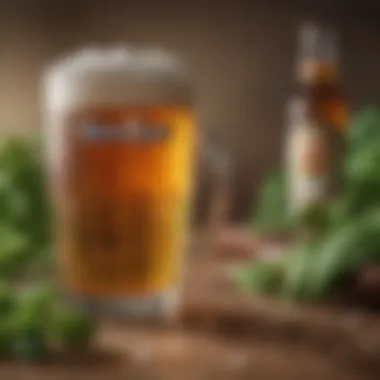
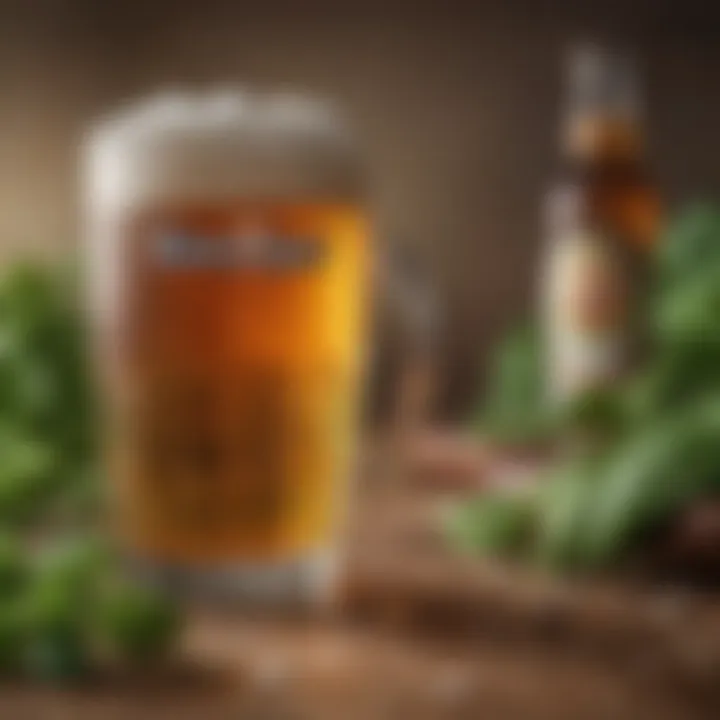
Statistics indicate that the acceptance of non-alcoholic options is rising dramatically. According to recent studies, approximately 60% of drinkers have experimented with non-alcoholic beer at least once, showing a shift in both curiosity and willingness to integrate these options into their drinking habits. The narrative is changing from "Why would anyone want this?" to "Why wouldn't I try this?" This evolution underscores a broader cultural acceptance of diverse drinking choices.
"The future isn’t just about choosing between alcoholic and non-alcoholic anymore; it’s about exploring a whole spectrum of flavors and experiences."
Social Settings for Consumption
Non-alcoholic beer is finding its way into various social settings, broadening the scope of occasions for consumption. Traditionally, one might envision a barbecue or a bar setting as the primary venues for beer enjoyment. However, with the increasing availability and acceptance of non-alcoholic options, these beverages are now part of a multitude of environments. From family-oriented picnics to professional networking events, non-alcoholic beer is carving its niche.
Restaurants, too, are adapting. Many are now featuring well-curated non-alcoholic beer selections alongside their wine and cocktail lists, appealing to an audience that wants social connection without the effects of alcohol.
When considering social settings, it’s evident that non-alcoholic beer enhances inclusivity. Friends may gather for an evening by the fire, enjoying burgers and fries, while some sip on an IPA with no alcohol. This advancement grants those who abstain for health reasons or personal choices the opportunity to partake in social rituals without feeling left out or uncomfortable.
In summary, the cultural and social implications of non-alcoholic beer represent a significant shift in contemporary drinking habits. This evolution not only reflects changing consumer preferences but also symbolizes a new approach to how we view and integrate beverages into our social lives.
Regulatory Landscape
The regulatory landscape surrounding non-alcoholic beer is pivotal for various reasons. First, it provides guidelines that ensure consumer safety and informed choices. With the growing appeal of non-alcoholic options, the standards governing their production and sale are increasingly scrutinized. Understanding these regulations not only enlightens consumers about what they’re drinking, but it also fosters industry integrity by enforcing quality and honesty in labeling.
Labeling Standards
Labeling standards are crucial in the non-alcoholic beer segment. These standards dictate what information must be disclosed on packaging. For instance, beverages labeled as non-alcoholic in many regions are required to contain less than 0.5% alcohol by volume (ABV). This requirement might seem trivial, but it can significantly influence consumer perception.
“By presenting clear and accurate labeling, companies can build trust with their customers and avoid legal issues.”
Additionally, labels often provide important nutritional information, including calorie counts, ingredients, and allergen warnings, so people can make choices aligned with their health goals. The transparency offered by strict labeling standards allows consumers to compare products effectively and look for what's best suited to their preferences.
Alcohol Content Regulations
Alcohol content regulations are another cornerstone of the regulatory framework for non-alcoholic beer. These regulations help differentiate between true non-alcoholic beverages and those that may still contain a significant amount of alcohol. For instance, in the United States, many states specify that beverages containing up to 0.5% ABV can be marketed as non-alcoholic, while other countries may have stricter definitions.
Understanding these distinctions is vital for consumers, especially those who may abstain from alcohol due to health, personal, or religious reasons. Manufacturers, too, need to navigate these regulations to ensure compliance. Failure to do so can lead to product recalls, fines, or reputational damage, emphasizing the importance of adhering to these legalities.
In summary, the regulatory landscape plays an essential role in the world of non-alcoholic beer, impacting everything from labeling to alcohol content. Consumers benefit from clearer choices, while manufacturers gain from a structured framework fostering fair practices and enhancing trust within the market.
Pairing Non-Alcoholic Beer with Food
Pairing non-alcoholic beer with food is often overlooked but is equally important to recognize as traditional beer pairings. A common misconception is that the absence of alcohol diminishes the complexity and flavors available in non-alcoholic options. In reality, these beers offer a robust palette that can enhance culinary experiences just as well.
Understanding the nuances of flavors in non-alcoholic beers contributes significantly to a well-rounded dining experience. It invites a casual exploration of different tastes and offers individuals an opportunity to enjoy drinks that complement their meals without the blurring effects of alcohol. When done thoughtfully, pairing non-alcoholic beer can enhance flavors, create balance, and even surprise the palate in delightful ways.
Suggested Food Pairings
- Grilled Chicken
Grilled chicken is famed for its versatility. A crisp non-alcoholic lager, with its light and refreshing notes, accompanies grilled chicken beautifully. The beer's effervescence cuts through the meat’s richness, allowing for a harmonious fusion of flavors. - Spicy Asian Cuisine
For something with a bit more punch, pairing a hoppy non-alcoholic IPA with spicy Thai food can be a revelation. The bitterness from the hops counters the spice, creating a balanced experience that excites the taste buds. - Rich Chocolate Desserts
Surprisingly enough, malt-forward non-alcoholic stouts complement dark chocolate desserts remarkably well. The sweetness and depth of the stout can amplify the richness of chocolate, making for a dessert pairing that’s hard to resist. - Salads with Citrus Dressing
A light non-alcoholic wheat beer pairs delightfully with salads featuring citrus dressings. The beer's subtle sweetness and natural flavor will enhance the vibrancy of the salad ingredients, creating a bright and uplifting dish. - Cheese Boards
Hard and soft cheeses alike can find a friend in non-alcoholic beers. For softer cheeses, a light pilsner works wonders, while harder cheeses might pair better with bolder non-alcoholic ales.
Culinary Experimentation
The world of non-alcoholic beer offers a playground for culinary experimentation. Chefs and home cooks can dive deep into pairing combinations that challenge the status quo.
- Marinades and Sauces
A bold non-alcoholic porter can be used in marinades, lending its rich flavor to meats and vegetables. The same goes for sauces—incorporating non-alcoholic beers in reductions creates depth and layers. - Baking
In baking, non-alcoholic beer can replace traditional ingredients, such as water or milk, adding unique flavors and textures. For instance, using a non-alcoholic stout in chocolate cake can elevate the richness of the dessert considerably. - Sour Beers with Pickling
Sour non-alcoholic beers can create a fantastic zing in pickling liquids. Experimenting with different beer styles in preserving fruits or vegetables leads to exciting results.
Incorporating non-alcoholic beer into culinary endeavors invites creativity while maintaining the essence of a pleasurable dining experience. By thinking outside the box, both amateur cooks and seasoned chefs can enhance flavors in unexpected ways.
Future of Non-Alcoholic Beer
As the world moves towards healthier lifestyles and seeks alternatives to alcoholic beverages, the future of non-alcoholic beer is looking particularly bright. This segment of the beverage industry has seen remarkable growth and innovation, signalling a shift in consumer preferences. With the increasing awareness around health and wellness, more individuals are leaning toward non-alcoholic options that allow them to enjoy the taste of beer without the drawbacks associated with alcohol consumption.
The importance of discussing the future of non-alcoholic beer lies not just in its market potential, but in how it reflects changing societal values. The drink caters to a diverse audience ranging from health-conscious consumers to designated drivers and individuals recovering from addiction. This inclusivity broadens the appeal of non-alcoholic beer, making it a versatile choice for various occasions.
Predicted Trends
- Enhanced Flavor Profiles: Expect to see brands investing significantly in improving the taste of non-alcoholic beers. As more breweries venture into this space, competition will drive innovation. Consumers have developed a palate for quality, meaning that a bland beverage won't cut it anymore. Brands will focus on developing richer and more complex flavors, appealing to traditional beer lovers.
- Broader Variety: The days of limited options are numbered. As the category grows, expect a rise in diverse styles such as stouts, porters, and IPAs. Just like craft beer saw an explosion in varieties, the same will happen for non-alcoholic beers.
- Sustainability Focus: Many consumers are becoming more environmentally conscious. Breweries will need to adopt sustainable practices in both production and packaging. This could include sourcing organic ingredients and using eco-friendly packaging to capture the attention of environmentally-aware consumers.
- Hybrid Beverages: A notable trend is blending non-alcoholic beer with other beverages, like kombucha or flavored sparkling waters. This mashup not only provides unique flavors but also targets consumers seeking health benefits alongside their refreshment.
"As more people seek healthier lifestyles, the demand for alternatives to traditional alcohol will grow. Non-alcoholic beer is poised to meet that surge in demand."
Innovations on the Horizon
- Advanced Brewing Techniques: Innovations in brewing technology are expected to take center stage. Techniques like spin evaporation and reverse osmosis might become commonplace to create better-tasting non-alcoholic ales that closely resemble their higher-alcohol counterparts.
- Nutritional Add-ons: There's room for the incorporation of functional ingredients such as probiotics or vitamins. This could position non-alcoholic beers as not only a refreshment but also as a health-boosting option, becoming popular among fitness enthusiasts and health-conscious individuals.
- Smart Packaging: Future innovations may include smart packaging that tracks consumption habits or freshness. This would enhance consumer engagement and could offer personalized experiences for loyal customers.
- Collaborations with Renowned Chefs: Collaborations between non-alcoholic beer brands and culinary influencers could create unique offerings that are designed for specific food pairings. This can pique consumer interest and position these beverages as essential for pairing with gourmet dining, further elevating their status.







